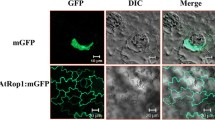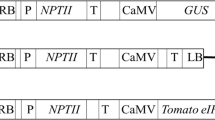Abstract
The STH-2 gene is rapidly activated in potato leaves and tubers following elicitation or infection by Phytophthora infestans. However, its biochemical function remains unknown. In order to ascertain if STH-2 protein is directly involved in the defense of potato against pathogens, the STH-2 coding sequence under the control of the CaMV 35S promoter was introduced into potato plants. Transgenic plants expressing the STH-2 gene were analyzed for an altered pattern of susceptibility to a compatible race of P. infestans and to potato virus X. Results indicate that constitutive expression of the STH-2 gene did not reduce susceptibility of potato to these pathogens.
Similar content being viewed by others
References
Alexander D, Glascock C, Pear J, Stinson J, Ahl-Goy P, Gut-Rella M, Ward E, Goodman R, Ryals J: Systemic acquired resistance in tobacco: use of transgenic expression to study the functions of pathogenesis-related proteins. Abstr. 70, Program and Abstracts, Sixth International Symposium on Molecular Plant-Microbe Interactions (Seattle, July 11–16, 1992).
Barrat DHP, Clark JA: Proteins arising during the late stages of embryogenesis in Pisum sativum L. Planta 184: 14–23 (1991).
Bevan M: Binary Agrobacterium vectors for plant transformation. Nucl Acids Res 12: 8711–8721 (1984).
Breiteneder H, Pettenburger K, Bito A, Valenta R, Kraft D, Rumpold H, Scheiner O, Breitenbach M: The gene coding for the major birch pollen allergen BetvI, is highly homologous to a pea resistance response gene. EMBO J 8: 1935–1938 (1989).
Broglie K, Chet I, Holliday M, Cressman R, Biddle P, Knowlton S, Mauvais CJ, Broglie R: Transgenic plants with enhanced resistance to the fungal pathogen Rhizoctonia solani. Science 254: 1194–1197 (1991).
Chiang CC, Hadwiger LA: Cloning and characterization of a disease resistance response gene in pea inducible by Fusarium solani. Mol Plant-Microbe Interact 3: 78–85 (1990).
Collinge DB, Slusarenko AJ: Plant gene expression in response to pathogens. Plant Mol Biol 9: 389–410 (1987).
Constabel CP, Brisson N: The defense-related STH-2 gene product of potato shows race-specific accumulation after inoculation with low concentrations of Phytophthora infestans zoospores. Planta 188: 289–295 (1992).
Crowell DN, John MF, Russell D, Amasino RM: Characterization of a stress-induced, developmentally regulated gene family from soybean. Plant Mol Biol 18: 459–466 (1992).
DeBlock M: Genotype-independent leaf disc transformation of potato (Solanum tuberosum) using Agrobacterium tumefaciens. Theor Appl Genet 76: 767–774 (1988).
Dudler R, Hertig C, Rebmann G, Bull J, Mauch F: A pathogen-induced wheat gene encodes a protein homologous to glutathione-S-transferases. Mol Plant-Microbe Interact 4: 14–18 (1991).
Faulkner G, Kimmins WC: Staining reactions of the tissue bordering lesions induced by wounding, tobacco mosaic virus, and tobacco necrosis virus in bean. Phytopathology 65: 1396–1400 (1975).
Hahlbrock K, Scheel D: Physiology and molecular biology of phenylpropanoid metabolism. Annu Rev Plant Physiol Plant Mol Biol 40: 347–369 (1989).
Harlow E, Lane D: Antibodies: A Laboratory Manual. Cold Spring Harbor Laboratory, Cold Spring Harbor, NY (1988).
Hilder VA, Gatehouse AMR, Sheerman SE, Barker RF, Boulter D: A novel mechanism of insect resistance engineered into tobacco. Nature 320: 160–163 (1987).
Hoekema A, Hirsch PR, Hooykaas PJJ, Schilperoort RA: A binary plant vector strategy based on separation of the Vir and T-region of the Agrobacterium tumefaciens Ti-plasmid. Nature 303: 179–180 (1983).
Jefferson RA, Kavanagh TA, Bevan MW: GUS fusions β-glucuronidase as a sensitive and versatile fusion marker in higher plants. EMBO J 6: 3901–3907 (1987).
Lamb CJ, Lawton MA, Dron M, Dixon RA: Signals and transduction mechanisms for activation of plant defenses against microbial attack. Cell 56: 215–224 (1989).
Linthorst HJM, Meuwissen RLJ, Kauffman S, Bol JF: Constitutive expression of pathogenesis-related proteins PR-1, GRP, and PR-S in tobacco has no effect on virus infection. Plant Cell 1: 285–291 (1989).
Lisker N, Kuc J: Elicitors of sesquiterpenoid accumulation in potato tuber slices. Phytopathology 67: 1356–1359 (1977).
Matton DP, Brisson N: Cloning, expression, and sequence conservation of pathogenesis-related gene transcripts of potato. Mol Plant-Microbe Interact 2: 325–331 (1989).
Neuhaus J-M, Ahl-Goy P, Hinz U, Flores S, MeinsJr F: High-level expression of a tobacco chitinase gene in Nicotiana sylvestris. Susceptibility of transgenic plants to Cercospora nicotianae. Plant Mol Biol 16: 141–151 (1991).
Rohwer F, Fritzemeier K-H, Scheel D, Hahlbrock K: Biochemical reactions of different tissues of potato (Solanum tuberosum) to zoospores or elicitors from Phytophthora infestans. Planta 170: 556–561 (1987).
Sambrook J, Fritsch EF, Maniatis T: Molecular Cloning: A Laboratory Manual. Cold Spring Harbor Laboratory Press, Cold Spring Harbor, NY (1989).
Shih M, Kuc J, Williams EB: Suppression of steroid glycoalkaloid accumulation as related to rishitin accumulation in potato tubers. Phytopathology 63: 821–826 (1973).
Somssich IE, Schmelzer E, Kawalleck P, Hahlbrock K: Gene structure and in situ transcript localization of pathogenesis-related protein 1 in parsley. Mol Gen Genet 213: 93–98 (1988).
Stolle K, Schöber B: Neue Methode zur Kultur von Phytophthora infestans (Mont.) de Bary in Flüssigmedien. Potato Res 25: 273–276 (1982).
Walter MH, Liu J-W, Grand C, Lamb CJ, Hess D: Bean pathogenesis-related (PR) proteins deduced from elicitor-induced transcripts are members of a ubiquitous new class of conserved PR proteins including pollen allergens. Mol Gen Genet 222: 353–360 (1990).
Warner SAJ, Scott R, Draper J: Characterisation of a wound-induced transcript from the monocot asparagus that shares similarity with a class of intercellular pathogenesis-related (PR) proteins. Plant Mol Biol 19: 555–561 (1992).
Author information
Authors and Affiliations
Rights and permissions
About this article
Cite this article
Constabel, C.P., Bertrand, C. & Brisson, N. Transgenic potato plants overexpressing the pathogenesis-related STH-2 gene show unaltered susceptibility to Phytophthora infestans and potato virus X. Plant Mol Biol 22, 775–782 (1993). https://doi.org/10.1007/BF00027364
Received:
Accepted:
Issue Date:
DOI: https://doi.org/10.1007/BF00027364




